 The practice of yoga has been known to improve an individual’s physical and mental well-being through movement and meditation, but a common misconception is the idea that all yoga practices are the same. That notion could not be further from the truth. With several various types of yoga, it can be difficult to determine which is the best fit for you and your lifestyle.
The practice of yoga has been known to improve an individual’s physical and mental well-being through movement and meditation, but a common misconception is the idea that all yoga practices are the same. That notion could not be further from the truth. With several various types of yoga, it can be difficult to determine which is the best fit for you and your lifestyle.
While all forms of yoga presumably increase flexibility, improve posture, decrease stress levels, and increase focus, to name just a few of the health benefits, it is important to find a branch of yoga which resonates with your mind, body, and soul.
Below we delve into some of the more common yoga practices:
Hatha Yoga
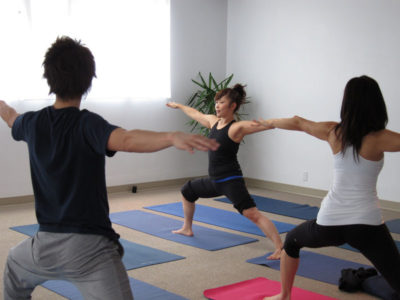 Hatha yoga is a general category that encompasses several forms of yoga. Classes marketed as teaching hatha yoga are typically a gentle introduction into the physical practice of yoga. Hatha practice places emphasis on the mind/body connection and the ability to ground one’s self in the present moment.
Hatha yoga is a general category that encompasses several forms of yoga. Classes marketed as teaching hatha yoga are typically a gentle introduction into the physical practice of yoga. Hatha practice places emphasis on the mind/body connection and the ability to ground one’s self in the present moment.
Vinyasa Yoga
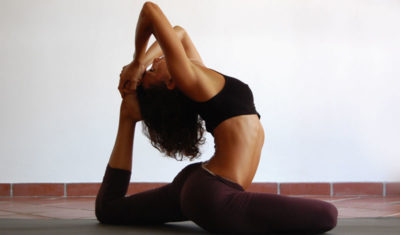 The word “vinyasa” in Sanskrit loosely means “to place in a special way.” The practice of vinyasa yoga puts emphasis on the connection between postures and the breath. Vinyasa is typically a faster paced, breath-linked series of postures, which builds physical and mental strength.
The word “vinyasa” in Sanskrit loosely means “to place in a special way.” The practice of vinyasa yoga puts emphasis on the connection between postures and the breath. Vinyasa is typically a faster paced, breath-linked series of postures, which builds physical and mental strength.
Restorative Yoga
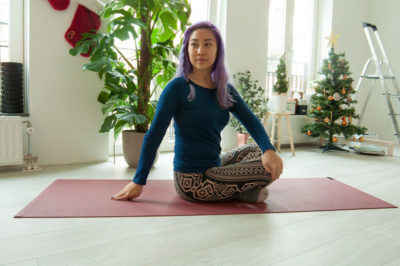 A restorative practice focuses on promoting a sense of healing and deep relaxation. More slowly paced than many other forms of yoga, restorative yoga consists of a few simple postures that are held for several minutes each and supported by the use of yoga props.
A restorative practice focuses on promoting a sense of healing and deep relaxation. More slowly paced than many other forms of yoga, restorative yoga consists of a few simple postures that are held for several minutes each and supported by the use of yoga props.
Aerial Yoga
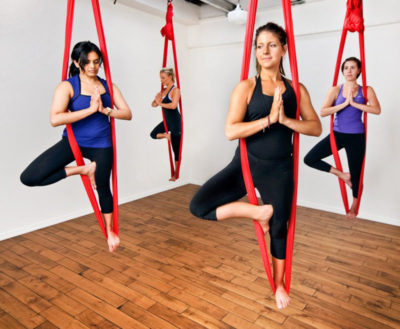 If you’re looking for an unconventional yoga practice, aerial yoga turns the preconceived notions of what yoga is, upside down, quite literally. A mix of yoga and aerial acrobatics, aerial yoga allows you to stretch deeply with the support of a silk hammock, suspended from the ceiling. Supported, yogis can invert, or hang upside down, which can help decompress the spinal column, and increase blood flow throughout the body.
If you’re looking for an unconventional yoga practice, aerial yoga turns the preconceived notions of what yoga is, upside down, quite literally. A mix of yoga and aerial acrobatics, aerial yoga allows you to stretch deeply with the support of a silk hammock, suspended from the ceiling. Supported, yogis can invert, or hang upside down, which can help decompress the spinal column, and increase blood flow throughout the body.
Bikram Yoga
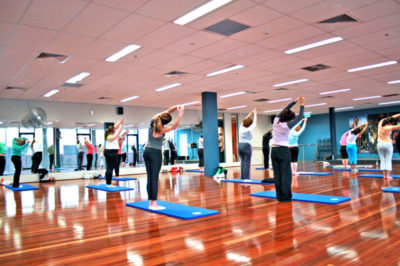 If you’re looking to practice in 90 to 100 degree temperatures, then Bikram yoga is for you. Typically beginner Bikram classes consist of a 90-minute practice of the same 26 postures. While the heated environment can promote deeper muscle relaxation and increased flexibility, it would not be recommended for people with sensitivity to heat or with certain cardiac and respiratory ailments.
If you’re looking to practice in 90 to 100 degree temperatures, then Bikram yoga is for you. Typically beginner Bikram classes consist of a 90-minute practice of the same 26 postures. While the heated environment can promote deeper muscle relaxation and increased flexibility, it would not be recommended for people with sensitivity to heat or with certain cardiac and respiratory ailments.
So whether you are looking to unwind and relax with a restorative practice, or work up a sweat with a Bikram practice, there is a subset of yoga waiting to be discovered and enjoyed by all.
Katherine Alexis Athanasiou is a certified physician assistant (PA-C).




















